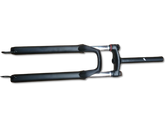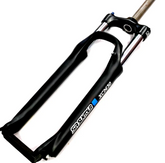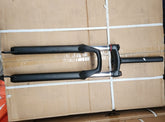Complete Guide to Bicycle Suspension: Everything You Need to Know
Looking to upgrade your ride or understand the benefits of a bicycle suspension system? Whether you're cruising city streets or tackling rough trails, having the right cycle suspension can make a world of difference in comfort, control, and performance. In this guide, we’ll cover everything about suspension for cycle models and explain why a good suspension fork is essential for your biking experience.
What is a Suspension Fork?
A suspension fork—often referred to as a bike suspension fork or suspension fork bike—is a key component mounted on the front of the bicycle to absorb shocks from rough terrain. Riders looking for comfort often choose bikes with fork suspension, commonly seen on MTBs and hybrid models. If you're shopping for a fork bicycle, you’ll want to ensure it comes with a high-quality bike fork that suits your terrain needs.
Types of Cycle Suspension
There are generally two kinds of suspension for cycles: front-only (fork suspension) and full-suspension bikes. While full-suspension bikes are great for aggressive trails, a cycle fork suspension is often more than enough for casual riders and commuters. Riders commonly refer to these setups as cycle shockers or bike suspension forks, both designed to enhance ride comfort.
Why Suspension Matters
If you’ve ever hit a pothole at speed, you know how valuable a cycle shock absorber can be. With a proper bike suspension, your ride becomes smoother, more stable, and much safer. The bike forks work alongside tires and frames to cushion your ride, making it easier on your body and improving traction.
Suspension Cycle Options in India
Searching for the best suspension cycle or want to know the latest cycle suspension price? Prices vary based on build quality, travel range, and brand. You’ll also find various options under the term suspension fork for bicycle, including alloy and carbon models. For budget shoppers, comparing bicycle shocker price ranges can help find the perfect match without breaking the bank.
Choosing the Right Fork
When picking a bike fork or fork bike, consider your riding style. A trail rider may opt for long-travel bike suspension forks, while city commuters might prefer lightweight, rigid designs. Whichever you choose, ensure your cycle suspension system matches the frame and wheel size for optimal performance.
Conclusion
Whether you’re a weekend rider or a daily commuter, investing in the right cycle suspension—especially a reliable suspension fork—can greatly improve your ride. From bike suspension fork upgrades to full cycle shocker systems, the market offers a wide variety of choices to suit every rider and budget.
Suspension Forks
Suspension forks are a type of fork that absorbs shocks, helping to smooth out the ride, especially on rough terrain. They are mostly used on mountain bikes but are also found in some hybrid or touring bikes.
Types of Suspension Forks
-
Hardtail Suspension Forks
-
Description: Hardtail bikes have suspension only in the front (via the fork), with a rigid rear triangle (no rear suspension).
-
Best For: Cross-country and light trail riding. They are lighter than full-suspension bikes, making them ideal for riders who want to prioritize speed and efficiency.
-
Full Suspension Forks (with rear suspension)
-
Description: Full suspension bikes have both a suspension fork in the front and a shock absorber in the rear. These forks are often used in combination with rear suspension for maximum comfort and control on rugged terrain.
-
Best For: Technical trails, downhill mountain biking, and rougher terrain where maximum shock absorption is needed.
-
Air Suspension Forks
-
Description: These forks use air as the main medium for absorbing impacts. They offer adjustable air pressure, which allows riders to fine-tune their suspension depending on their weight, riding style, and terrain.
-
Best For: Riders who want a customizable suspension experience.
-
Coil Suspension Forks
-
Description: These forks use a metal coil spring to absorb impacts. Coil forks are typically more affordable and provide a more progressive feel compared to air forks.
-
Best For: Entry-level to mid-range mountain biking and riders who don’t need extensive adjustability.
-
Travel (Fork Stroke)
-
Description: The travel (measured in millimeters) is the amount the suspension fork can compress. More travel (e.g., 120mm) offers better shock absorption on rougher terrain, while less travel (e.g., 80mm) is typically used for lighter trail use and cross-country riding.
Suspension Fork Components
-
Stanchions: The upper part of the fork that slides inside the lower legs of the fork. They may need regular cleaning and maintenance to avoid damage.
-
Dropouts: The part of the fork where the wheel axle is inserted. If these are bent, they can compromise the fork's alignment.
-
Air Valve: For air suspension forks, an air valve allows you to adjust the air pressure to suit your needs.
-
Springs: For coil suspension forks, the springs help with shock absorption. They can wear out or break if they are overused or improperly maintained.
-
Damper: The damper controls how the suspension fork moves after compression. Replacing or servicing the damper can help adjust the fork’s rebound and compression settings.
Common Suspension Fork Spare Parts
-
Seals and Wipers: These are used to keep dirt and water out of the fork’s internals. Over time, they can wear out or become damaged.
-
Oil (for damping): Suspension forks rely on oil for damping. If the oil level is too low or dirty, the fork’s performance will suffer.
-
Springs (Coil Forks): Coil forks may need replacement springs based on the rider’s weight or riding preferences.
-
Air Springs (Air Forks): The air spring can lose pressure or develop leaks, which will affect the fork’s performance.
-
Crown Race: The part of the fork that sits against the headset and allows smooth turning. It can wear out and may need to be replaced after heavy use.
Maintaining Suspension Forks
Suspension Fork Maintenance
-
Regular Cleaning: After rides, especially off-road, clean the stanchions and seals to remove dirt and debris.
-
Oil and Seal Maintenance: Suspension forks need oil and seals replaced periodically. Depending on usage, it might be every 50-100 hours of riding.
-
Air Pressure Adjustment: For air forks, ensure you adjust the air pressure to suit your weight and riding style. Low air pressure can reduce performance, while high pressure can make the fork too stiff.
-
Suspension Forks: Suspension forks absorb shock and smooth out the ride. Whether you choose a coil or air fork, make sure it matches the type of terrain you plan to ride on. Regular maintenance ensures long-lasting performance and comfort.












